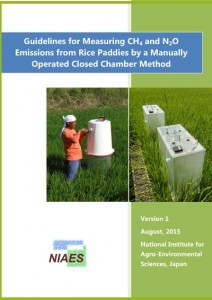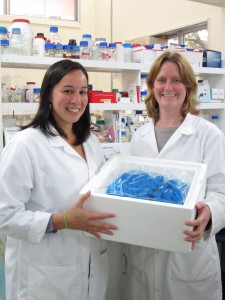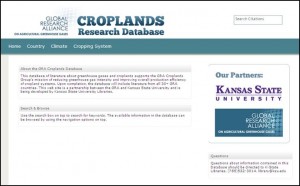The National Institute for Agro-Environmental Sciences (NIAES) has announced the media release of the new publication, “Guidelines for Measuring Methane (CH4) and Nitrous Oxide (N2O) Emissions from Rice Paddies by a Manually Operated Closed Chamber Method”.
The guidelines are supported by the MIRSA-2 project “Technology development for circulatory food production systems responsive to climate change (Development of mitigation option for greenhouse gas emissions from agricultural lands in Asia)”, and funded by MAFF, Japan, to support the goals and objectives of the Paddy Rice Research Group of the Global Research Alliance.
The GRA Rice Research Group in collaboration with IRRI, CIAT and the CCAC are lanching a project to reduce methane emissions intensities by 30% in eligible systems by 2019, while increasing food security and adaptation capacities of farmers.
The project will produce technical and policy guidance for implementing scalable mitigation options in paddy rice in Southeast Asia, South Asia, and Latin America. For more information see here.
The third newsletter on United Kingdom(UK) activities which support the Global Research Alliance (GRA) on Agricultural Greenhouse Gases is out now.
UK technical and scientific participation in the GRA builds upon the UK Government investment in the UK Agricultural Greenhouse Gas (GHG) Research Platform and aims to promote and enhance UK research into agricultural GHG monitoring and mitigation. To read the Newsletter click here.
AGGP is the initial response of Canada to the GRA initiative. It was open to Canadian organizations and will come to completion in 2015. The program will provide Canadian farmers with technologies to manage their land and livestock in a way that will mitigate greenhouse gas (GHG) emissions. To find out more: http://www.agr.gc.ca/eng/?id=1331047113009#l1
An article in support of the Paddy Rice Research Group – “Appropriate frequency and time of day to measure methane emissions from an irrigated rice paddy in Japan using the manual closed chamber method” has been published in the Greenhouse Gas Measurement and Management Journal. This research article is the first outcome for the Paddy Rice Research Group activity standardising measurements of greenhouse gas emissions from paddy rice. The next step for this research will be to compare data from irrigated rice paddies with different water management and tropical climates.
Kazunori Minamikawa, Kazuyuki Yagi, Takeshi Tokida, Bjoern Ole Sander & Reiner Wassmann (2012): Appropriate frequency and time of day to measure methane emissions from an irrigated rice paddy in Japan using the manual closed chamber method, Greenhouse Gas Measurement and Management, 2:2-3, 118-128.
Abstract
Rice agriculture is a large anthropogenic source of atmospheric methane (CH4). The reliable estimation of CH4 emissions requires frequent measurements to trace diurnal and seasonal variations. To evaluate the appropriate intervals and optimal time of day to measure CH4 emissions using the manual closed chamber method, this study analysed four datasets of CH4 fluxes in a Japanese irrigated rice paddy measured at 2-hour intervals using the automated closed chamber method. The typical diurnal variation in the CH4 flux was observed after the rice’s heading stage, during which the daily time-weighted mean CH4 flux was observed twice, in the 08:00–11:59 and 18:00–21:59 time windows. During the flooded rice-growing period, the CH4 emissions, which were estimated by weekly measurements once per day during the 10:00–11:59 time window, corresponded to 93–106% of the emissions calculated using the automated measurement method. In contrast, no regular measurement strategies produced a satisfactory estimate of the CH4 emissions during the non-flooded rice-growing period because of a sharp increase in the CH4 flux just after the drainage. Consequently, the combination of weekly measurements once per day at approximately 10:00 as local mean time for the flooded rice-growing period and daily measurements once per day during the daytime for 1 week after each drainage event is recommended as a strategy to obtain the estimation with a ±10% error.
Read the complete article: Greenhouse Gas Measurement and Management (subscription required)
A priority project for the Alliance’s Livestock Research Group has been the evaluation of the USA developed GreenFeed (C-Lock) system to measure methane emissions from cattle in herd grazing situations.
An international collaboration between scientists in New Zealand and the USA to evaluate field methane measurement from cattle using the C-Lock system (an automated methane measurement system). The US scientists had developed the C-Lock system for a temperate grazing pastoral system. The UK and Australian governments have invested in the purchase of C-Lock systems and will spend time trialling and evaluating the system for use in their countries, but using the results from this study as background information.
A brief report on the first evaluation of this system under controlled conditions in New Zealand may be requested from the authors. Please visit the LRG technical information and knowledge page for more information.
An article has been published in the Journal of Agricultural & Food Information about the development of a literature database for the Alliance’s Croplands Research Group. The database allows members of the Croplands Research Group to search and upload references of published literature concerned with mitigating greenhouse gas emissions from croplands by country, climate or cropping system.
The database was developed by faculty and staff at Kansas State University Libraries in collaboration with Dr Chuck Rice of Kansas State University. The article covers the development and implementation of the database as well as lessons learned.
The Croplands Research Group is happy to have contributed to this published paper and is grateful to Chuck Rice and K-State for their partnership.
The article can be downloaded from the Journal of Agricultural & Food Information
Livia Olsen, Tara Baillargeon & Harish Maringanti (2012): Developing an Open Access Croplands Research Database Through Global Collaboration, Journal of Agricultural & Food Information, 13:1, 35-44.
AgResearch scientists Gemma Henderson and Peter Janssen are conducting a census of rumen microbes from farmed ruminants in different parts of the world. This is being done as part of a Livestock Research Group project funded by New Zealand’s Ministry for Primary Industries (formerly Ministry of Agriculture and Forestry), as part of its commitment to the Global Research Alliance on Agricultural Greenhouse Gases (GRA).

Faith Cox and Dr Gemma Henderson with the package containing rumen samples from Canada, the first to arrive for the global census of rumen microbes
Ruminants have a modified digestive tract, in which the feed is first fermented by a complex community of microbes in a forestomach called the rumen. This has the advantage of converting feed that is of low energy value for mammals into products that are more valuable for the ruminant animal. However, one of the by-products of this fermentation is methane, which is released into the atmosphere.
This ruminant derived methane is implicated in global climate change. In response to this, research groups around the world are working to develop mitigation technologies to reduce the amounts of anthropogenic greenhouse gases produced from animal agriculture. Among these are technologies to inhibit the methane producing microbes or to direct the rumen fermentation away from methane and towards products that benefit the animal.
Modifying the rumen fermentation required a good knowledge of which microbes are to be targeted. If all ruminants harbour essentially the same microbes, then mitigation technologies targeting microbes are likely to be universal and transferable. This is where Gemma and Peter and their research come in. They are conducting a census of rumen microbes in samples being sent to them from a network of collaborators and colleagues from around the world. At the time of writing, samples have arrived or have been promised from Argentina, Australia, Brazil, Canada, Chile, Ethiopia, France, Ireland, Japan, Kenya, Korea, Mexico, Netherlands, New Zealand, Slovenia, United Kingdom, United States and Uruguay. Some countries are represented by multiple research institutes, which adds valuable diversity to the range of animals and feeding systems.
Any researchers who are interested in participating in this project and are able to supply samples can contact the project team at [email protected].
By Peter H. Janssen
In October 2010, the Livestock Research Group of the Global Research Alliance identified an initial set of priority projects that it considered would greatly assist the international research effort into livestock GHG mitigation. These included establishing research networks in rumen microbial genomics and animal genomics, producing best practice guidelines and technical manuals for the measurement of CH4 and N20, conducting a global survey of rumen microbial diversity, and the testing of a novel in-field CH4 system.
These first priority projects are now coming to an end. Download and read the project reports under the Global Research Alliance > Project Reports section on the website of the New Zealand Agricultural Greenhouse Gas Centre who administered the projects on behalf the Livestock Research Group.
On 8 June, the Inter-American Development Bank (IDB) and the Regional Fund for Agricultural Technology (FONTAGRO) signed an agreement to co-fund the first collaborative livestock emissions mitigation research project Latin America and the Caribbean. A contribution has also been made by the Government of New Zealand.
The project, selected during IDB FONTAGRO’s 2010 call for proposals and with additional funding support from New Zealand, will be implemented in Argentina, Chile, Colombia, the Dominican Republic and Uruguay, to improve the national greenhouse gas inventories and develop mitigation options adapted to the farming conditions of each country. The project is linked to as an example of collaborative activity arising from participating countries in the Alliance’s Livestock Research Group.
For more, please see http://www.iadb.org/en/news/news-releases/2011-06-08/climate-change-and-agriculture-in-latin-america,9398.html

